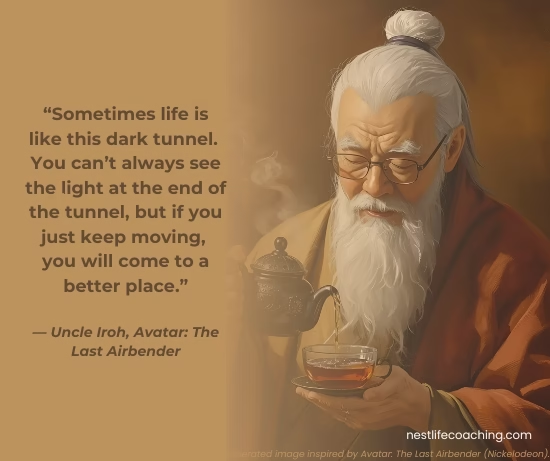Finding the Light at the End of the Tunnel for HSPs During Dark Seasons
There are moments in life when the path feels dim — when progress slows, clarity fades, and hope seems distant. For Highly Sensitive Persons, finding the light at the end of the tunnel for HSPs often means learning to move gently through dark times.
We don’t just notice the darkness, we feel it. We absorb emotion, energy, and uncertainty from the world around us. But as Uncle Iroh wisely said in Avatar: The Last Airbender:
“Sometimes life is like this dark tunnel. You can’t always see the light at the end of the tunnel, but if you just keep moving, you will come to a better place.”
This line captures a timeless truth: the light doesn’t disappear when we can’t see it. It waits for us to keep moving toward it.
The HSP Experience of the Dark Tunnel
Dr. Elaine Aron, author of The Highly Sensitive Person (1996), found that HSPs process emotional and sensory information more deeply than most people. This sensitivity brings empathy and creativity, but also emotional exhaustion during stress.
When challenges arise, HSPs may internalize the experience, thinking,
“Why can’t I move on faster?” or “Maybe something’s wrong with me.”
Nothing is wrong. Sensitivity is not weakness; it is heightened awareness — a strength in need of understanding.
1. Allow the Darkness Without Judgment
Many sensitive souls try to rush the process of healing. Yet mindfulness research (Kabat-Zinn, 2003) shows that accepting emotions, rather than resisting them, helps the body and mind regulate.
When the darkness feels overwhelming, say to yourself:
“It’s okay to feel this deeply. This moment is here to teach something valuable.”
Naming emotions with compassion opens the door to healing. The tunnel becomes a space for quiet transformation rather than a place of fear.
2. Keep Moving — Even Slowly
Movement doesn’t have to mean drastic change. It can mean one small, loving act each day: journaling, stepping outside, or sending a message to a friend.
Psychologists Jacobson et al. (2001) describe behavioral activation — the idea that small, intentional actions can lift emotional fog.
For HSPs, gentle progress could be:
- Writing a few lines about current emotions
- Taking a mindful walk outdoors
- Choosing rest without guilt
Each small act is movement. Gentle progress remains progress. Every mindful step draws one closer to light.
3. Trust That the Light Exists
Progress is often invisible before it becomes clear. Dr. Bessel van der Kolk (The Body Keeps the Score, 2014) explains that healing can occur beneath awareness as the body processes stored emotion.
Even when the light at the end of the tunnel cannot yet be seen, it still exists. Faith for sensitive souls means trusting the unseen work of healing that continues quietly within.
4. Seek Gentle Companionship
No one is meant to navigate darkness alone. Dr. Aron emphasizes that HSPs thrive with emotionally safe relationships — spaces where they feel heard rather than fixed.
Reach out to compassionate friends, support groups, or professionals who understand sensitivity. Connection acts as a lantern, illuminating the next step forward.
5. Integrate the Lessons of the Tunnel
Every dark season carries meaning: resilience, boundaries, gratitude, or rediscovered strength. Reflection helps integrate these lessons.
Consider questions such as:
- What inner strength emerged during this time?
- Which values became clearer?
- How might this growth help others facing similar darkness?
Healing deepens when lessons are honored and carried forward.
Final Reflection
Uncle Iroh’s words remind us that the light doesn’t vanish, it simply waits for us to arrive. For highly sensitive souls, each small step is an act of courage.
Keep walking. Keep trusting. The tunnel is only part of your transformation.
Ready to Find the Light Within?
Highly Sensitive Persons do not have to walk through dark times alone.
Professional life-coaching support can help transform sensitivity into strength, clarity, and grounded peace.
Book a free clarity session today with NEST Life Coaching and begin a gentle journey toward light and self-trust.
References
Aron, E. N. (1996). The Highly Sensitive Person: How to Thrive When the World Overwhelms You. Broadway Books.
Kabat-Zinn, J. (2003). Mindfulness-Based Interventions in Context: Past, Present, and Future. Clinical Psychology: Science and Practice, 10(2).
Jacobson, N. S., Martell, C. R., & Dimidjian, S. (2001). Behavioral Activation Treatment for Depression: Returning to Contextual Roots. Clinical Psychology: Science and Practice.
van der Kolk, B. A. (2014). The Body Keeps the Score: Brain, Mind, and Body in the Healing of Trauma. Viking.

